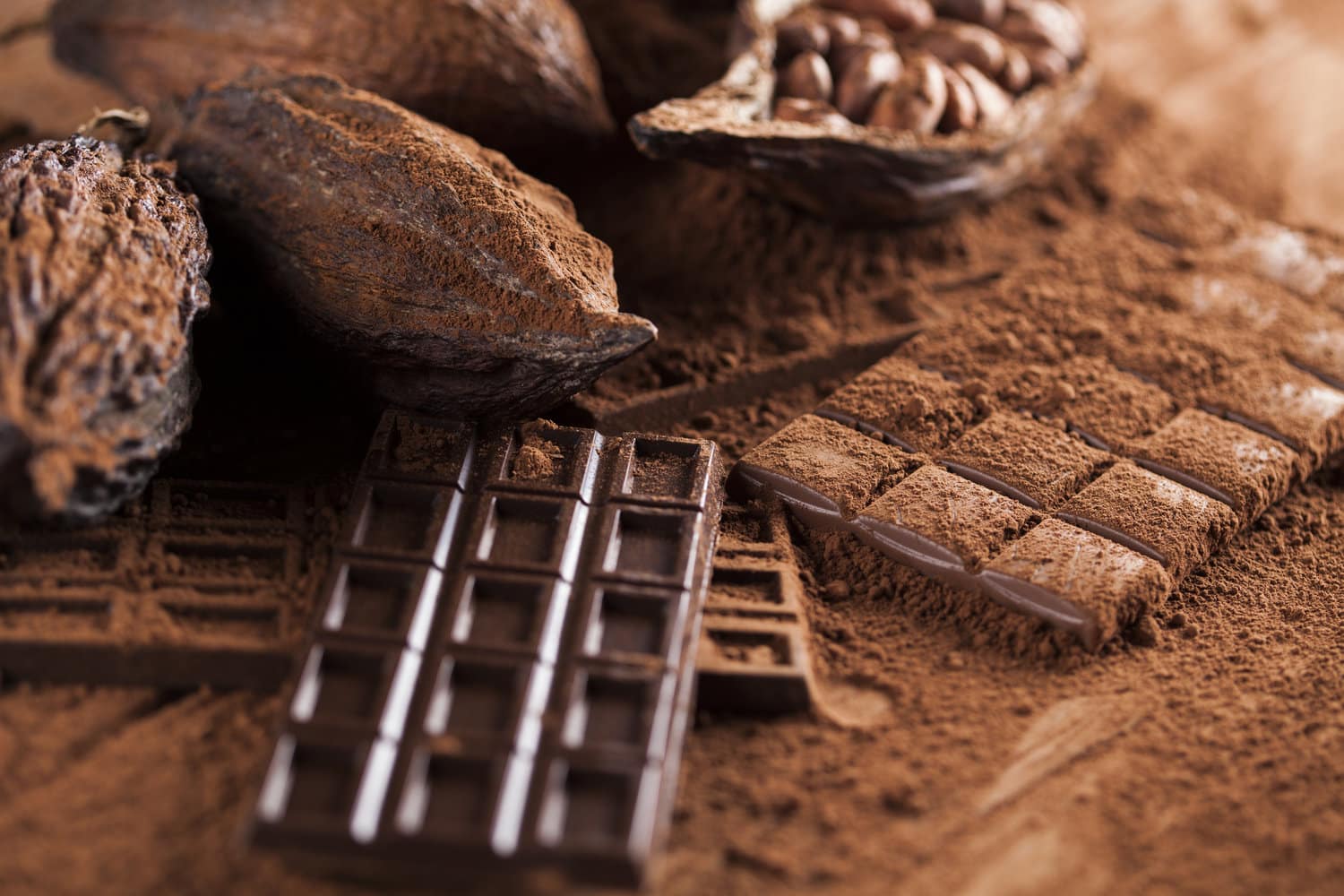Why chocolate makes us happy
Humans have been enjoying chocolate for thousands of years, and its popularity stems largely from the feelings of pleasure and happiness it can elicit. who doesn’t like chocolate? It’s just pronouncing the word and we already connect with its smell, our taste buds wake up and we imagine a piece melting in our mouth, right?
benefits of chocolate
Surely, it causes pleasure and guilt in equal parts because we think that it makes us fat and that it causes acne or cavities. Is that moment of satisfaction really worth it? The answer is yes, as long as we choose quality chocolate and do not go overboard.
1. Nervous system
Chocolate’s pleasure, satisfaction, and well-being have not gone unnoticed by neuroscientists who have studied the effects of cocoa on the nervous system. Cocoa contains tryptophan, an amino acid that is a precursor to serotonin, also known as the happiness hormone.In addition, it helps us to raise our spirits, thanks to substances such as phenylethylamines related to endorphins. Since they activate receptors that produce pleasure, they are responsible for feelings of euphoria and well-being.
2. Antioxidant
People frequently discuss chocolate’s antioxidant power, with over eight hundred identified substances in extremely high concentrations. Polyphenols and flavonoids, for example, prevent cell oxidation and fight free radicals. Keep in mind that these antioxidants are present in raw cocoa, but they are lost during the chocolate-making process, grain roasting, and paste homogenization. As a result, if we want to benefit from antioxidants, we should consume raw cacao.

Dark and medium bitter chocolate benefits
Its health benefits are primarily found in bitter or medium bitter, also known as dark or pure chocolate, and include improved blood circulation and cancer prevention due to its high antioxidant content. However, it also has the following advantages:
- It is beneficial to the heart because it contains powerful antioxidants from the flavonoid group, which include catechins, epicatechins, and procyanidins.
- It stimulates the central nervous system and cardiac muscles because it contains theobromine, a substance with a similar action to caffeine.
- It promotes feelings of well-being by stimulating the hormone serotonin, which improves mood and relieves stress.
- It lowers blood pressure and improves blood circulation by producing nitric oxide, a gas that relaxes the arteries.
- It raises good HDL cholesterol and lowers bad LDL cholesterol while also aiding in the prevention of atherosclerotic plaque formation in the arteries, which is why it has a cardioprotective effect due to its high antioxidant content.
- It improves brain function by increasing blood flow to the brain and containing stimulating substances such as caffeine and theobromine, which helps to prevent diseases such as Alzheimer’s.
- It protects the skin from the sun through bioactive compounds such as flavonoids, which protect the skin from UV ray damage.
- As long as it is consumed in moderation, it increases the feeling of satiety, making it excellent for weight control.
To obtain all of the properties of dark cocoa, eat a square of dark or medium bitter chocolate per day, which is approximately 6 g.
Benefits of white chocolate:
Because white chocolate is made entirely of cocoa butter, it lacks the nutritional value of milk, dark, or semi-sweet chocolate. Despite this, it contains very little caffeine and theobromine, which can be beneficial, especially for those who are unable to consume these substances due to medical reasons.
The Science of Chocolate and Happiness:
In recent years, scientists have begun to unravel the complex chemical interactions that occur between chocolate and the human brain, shedding light on why this delicious treat makes us feel so good.
Phenylethylamine is one of the key compounds in it that is responsible for its mood-enhancing effects (PEA). PEA is a naturally occurring compound found in many foods, but it is especially abundant in chocolate. When we eat it, PEA enters our bloodstream and travels to our brains, where it causes the release of endorphins. Endorphins are the body’s natural painkillers, as well as feelings of pleasure and euphoria.

The Psychological Benefits of Chocolate:
Chocolate is not only a tasty treat, but it also has several psychological benefits. Here are some of the ways it can improve our mental and emotional health:
Reduces Stress:
Eating it can aid in stress reduction. Consuming it has been shown in studies to lower cortisol levels, a hormone associated with stress.
Boosts Mood:
It contains compounds that can improve mood and reduce depression symptoms. These compounds include phenylethylamine (PEA), which triggers the release of endorphins, the body’s natural mood boosters.
Improves Cognitive Function:
Chocolate contains caffeine and theobromine, two stimulants that can improve cognitive functions such as memory, concentration, and alertness.
Enhances Pleasure:
The pleasure and enjoyment we get from eating chocolate can benefit our mental health. Its consumption causes the release of dopamine, a neurotransmitter associated with pleasure and reward.
Promotes Relaxation:
Chocolate’s compounds, including serotonin and magnesium, can help to promote relaxation and reduce anxiety.
Overall, chocolate has significant psychological benefits and can improve our overall sense of well-being. To avoid negative health consequences, it should be consumed in moderation and as part of a balanced diet.
Types of chocolate and how they differ:
The differences between the types of existing chocolates are:
- White cocoa: it has no cocoa and has more sugar and fat.
- Milk chocolate: It is the most common and has some amount of cocoa, milk, and sugar.
- Ruby or pink cocoa: it is a new type, containing 47.3% cocoa, milk, and sugar. Its pink coloration is natural, since it is made from the Ruby cocoa bean, so it does not have flavorings or colorings. In addition to this, it has a characteristic red fruit flavor.
- Medium bitter chocolate: it is the one that has 40 to 55% cocoa, a small amount of cocoa butter, and sugar.
- Dark or bitter chocolate: it is the one that contains more cocoa, between 60 to 85%, and less sugar and fat.
The higher the cocoa content, the greater the health benefits; as a result, the health benefits of medium bitter and dark are greater because they are high in antioxidants.
How to choose a good chocolate:
To reap all of these benefits, not just any chocolate will suffice. We can rule out milk chocolate and white chocolate right away because they are low-quality products that are high in sugar and thus negate the benefits of cocoa.
We must choose dark chocolate with a high percentage of cocoa and as little sugar as possible. There are dark chocolate bars with 50% cocoa and the rest is sugar. Don’t be taken in by the marketing.
Dark chocolate is made up of three basic ingredients: cocoa butter, cocoa powder, cocoa mass, and sugar. Some brands may also include lecithin, vanilla, or other flavors. We must carefully examine the label and select one with a minimum of 75% alcohol content with the goal of re-educating the palate and progressing to higher percentages. 85% is already very good, and 90 or higher is even better.As we know it comes from cocoa, a tree native to America that produces the fruit of the same name that is used as an ingredient in a wide range of foods. It was used for nutritional and medicinal purposes since ancient times.
Main benefits of chocolate (pure):
Reduce cholesterol:
Thanks to the oleic acid present in cocoa, chocolate helps lower cholesterol levels. Of course, consumption must be moderate.
Its consumption has satiating effects:
And we love that because we enjoy a few ounces and then we feel full, so we last until the next meal. Do you know why that happens? Because cocoa contains fiber. In addition, fiber helps keep cholesterol at bay, because it will be your great ally to maintain digestive health.
Chocolate reduces tension, relieves stress, and is a natural antidepressant:
There is nothing better than a bit of cocoa to brighten our day. And it is that another of the great advantages that are associated with it is the ability of pure It to reduce stress hormones in our body, feeling much more relieved after consuming it. Helps improve concentration and increases tranquility.
This is due to serotonin. Have you ever heard of her? Serotonin is present in cocoa and is considered a natural antidepressant, which adds to the endorphins (known as the happiness or pleasure hormone) that cocoa also contains.
Improves heart health:
As we anticipated at the beginning of the article, cocoa contains flavonoids, generally found in fruits and vegetables, and natural antioxidants that improve the ability of blood vessels to dilate. In addition, it inhibits the oxidation of “bad” cholesterol; fights the formation of blood clots; regulates the inflammatory response of blood vessels, and helps control blood pressure.
Smoother, more hydrated skin:
By containing antioxidants, cocoa helps fight free radicals, responsible for skin aging and wrinkles. Its consumption, therefore, helps to regenerate the skin, reduce inflammation, hydrate, and soften it.
FAQS Section:
What exactly is chocolate?
It is a food made from the cacao tree's beans. The beans are roasted and ground into a paste, which is then mixed with sugar and other ingredients to make various types.
ChocolatyWhat is the percentage of cacao in chocolate?
Cacao percentage is the percentage of cacao solids in the it. Higher percentages indicate a higher concentration of cacao solids and a lower concentration of sugar.
Is chocolate capable of causing acne?
Although there is no conclusive evidence that chocolate causes acne, some studies suggest that eating a lot of sugar and dairy products, which are common in it may aggravate acne symptoms.
Is chocolate a drug?
It contains compounds that can cause the release of endorphins and dopamine, resulting in feelings of pleasure and reward. While chocolate is not considered an addictive substance, some people may develop a psychological dependence on it.
Conclusion:
Finally, chocolate is more than just a tasty treat. It contains antioxidants, flavanols, caffeine, and theobromine, all of which can provide physical and psychological benefits. Its consumption can boost mood, improve cognitive function, reduce stress and anxiety, and promote social connection. However, because it is high in calories, sugar, and fat, it should be consumed in moderation. Furthermore, chocolate quality can vary greatly depending on factors such as cacao percentage and processing methods. We can enjoy the many benefits of it without jeopardizing our health by selecting high-quality chocolate and enjoying it in moderation. Overall, it is a fascinating and complex food that has been enjoyed for centuries and will most likely remain a favorite treat for future generations.
Video Credits:
The Infographics show

Dr. Mark Jenkins, MD - General Physician (California, USA)
Dr. Mark Jenkins is a board-certified general physician based in the United States, specializing in preventive medicine, nutrition, and lifestyle health. With years of clinical experience in primary care, he is dedicated to helping patients and readers alike make informed, science-based decisions about their well-being.
As a trusted medical reviewer and contributor to Healthfness.com, Dr. Jenkins ensures that all health content meets the highest standards of accuracy, safety, and evidence-based medicine. His expertise bridges modern medical science with practical, everyday wellness strategies, making complex topics approachable for all audiences.
Outside the clinic, Dr. Jenkins is passionate about living the healthy lifestyle he teaches. He enjoys hiking with his dog, experimenting with vegetarian cooking, and exploring the latest health research. He believes that small, consistent lifestyle changes lead to lasting health improvements, and he aims to inspire readers to take proactive steps toward a healthier, happier life.
Explore more of Dr. Jenkins’ evidence-based insights at Healthfness.com



